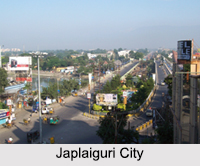 Jalpaiguri is a modern and well developed city in Jalpaiguri District of West Bengal. Jalpaiguri is the largest city in the northern part of West Bengal.
Jalpaiguri is a modern and well developed city in Jalpaiguri District of West Bengal. Jalpaiguri is the largest city in the northern part of West Bengal.
Naming of Jalpaiguri
"Jalpaiguri" is derived from the Bhutanese language term "je-le-pe-go-ri", which means that where the business of warm clothes are successful.
Location of Jalpaiguri
This city of north Bengal is located on the banks of the Teesta River on the foothills of the Himalaya Mountain Range in India. Jalpaiguri is situated at about 40 kilometers away from Siliguri, and more than 80 kilometers from Malda District.
Geography of Jalpaiguri
The latitudinal and longitudinal limit of Jalpaiguri is about 26.52 degree North to 88.73 degree East. The city has an average altitude of 75 meters from the sea level. The plain is fertile on the foothills of Himalaya Mountain Range in India. Jalpaiguri has many North East Indian Rivers and small streams. 
Climate of Jalpaiguri
The temperate season is prevailing through out the year. The summers of this city are tropical and quite hot with temperatures. The temperature is ranging in the mid 30 degree Celsius.
Demography of Jalpaiguri
According to the Population Census of 2011, Jalpaiguri had a population of 107,341. The population of the metropolitan region was 169,002, out of which 85,226 males and 83,787 females.
Education of Jalpaiguri
The education system of Jalpaiguri in Jalpaiguri District is just similar to Kolkata. Jalpaiguri Zilla School, Fanindradeb Institution, Sonaulla High School Holy Child School, Jalpaiguri, Sunitibala Sadar Girls School, D.A.V. School, Techno India School, Kendriya Vidyalaya, Saint Anthony`s Day School, Saint Paul`s School, Jalpaiguri and Government Girls High School are the strong holds of education system of Jalpaiguri.
Administration of Jalpaiguri
Jalpaiguri is the home to the circuit bench of the Kolkata High Court. The other seat is at Port Blair in the Andaman and Nicobar Islands.
Economy of Jalpaiguri
 Jalpaiguri has become an important center of trade and commerce in the northern part of West Bengal. The economy is dependent on tourism and small sector industries. This city has seen the fast industrial growth for steel, metal, cement and knowledge-based industries.
Jalpaiguri has become an important center of trade and commerce in the northern part of West Bengal. The economy is dependent on tourism and small sector industries. This city has seen the fast industrial growth for steel, metal, cement and knowledge-based industries.
Tourism in Jalpaiguri
Tourism in Jalpaiguri include the destinations like Buxa Tiger Reserve, Buxa fort, Murti, Rajabhatkhawa, Malbazar, Rasikbil, Raikatpara, Gorumara National Park, Rabindra Bhawan, Devi Chaudhurani Mandir, Jogomaya Kalibari, Chapramari Wildlife Sanctuary and many more. Darjeeling is connected with Sikkim - Darjeeling Himalaya Roadways.
Visiting Information
Jalpaiguri is connected with roadways, railways and airways. Bagdogra Airport is the nearest airport, while New Jalpaiguri has its own station. This city is connected with Jalpaiguri Road and Sikkim - Darjeeling Himalaya Roadways.



















